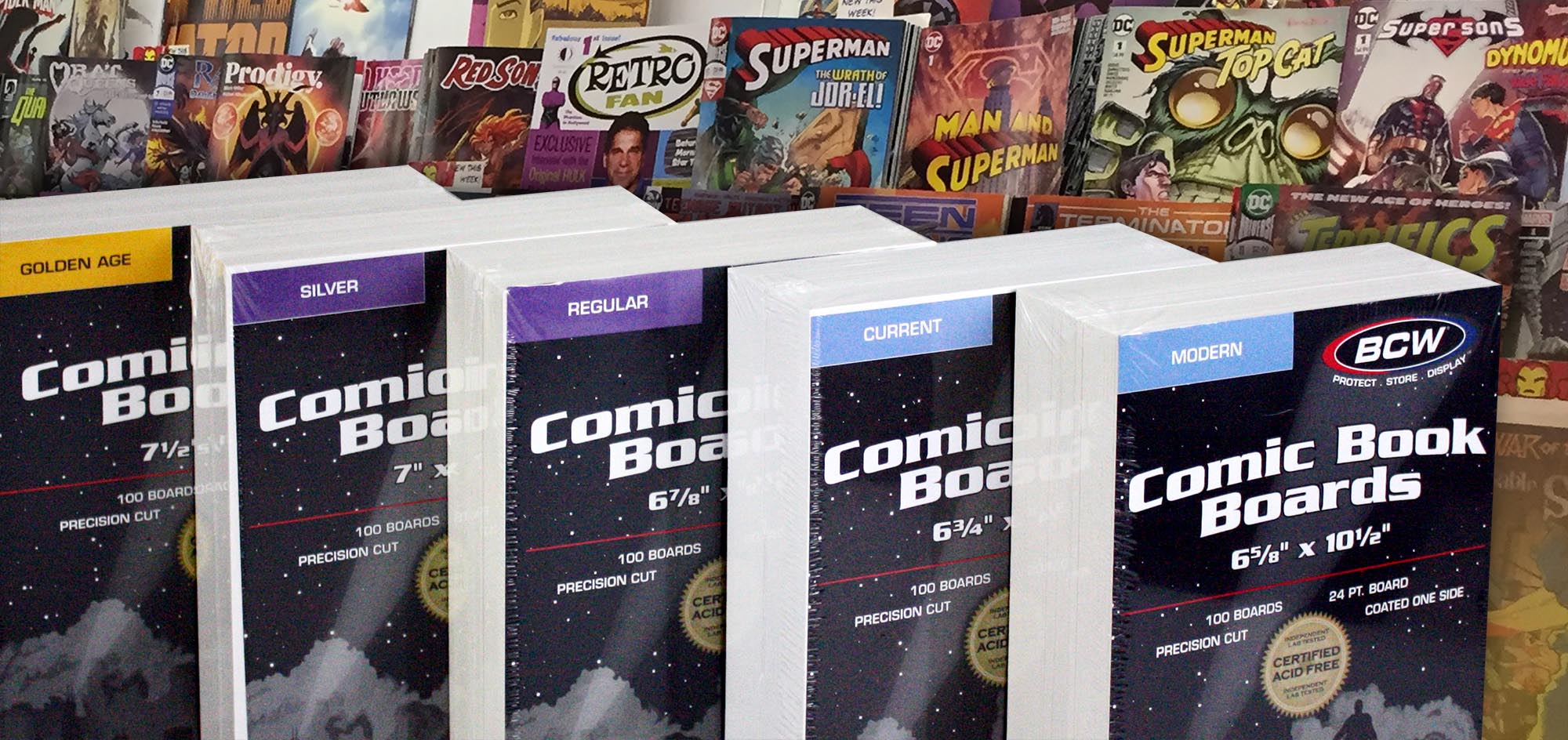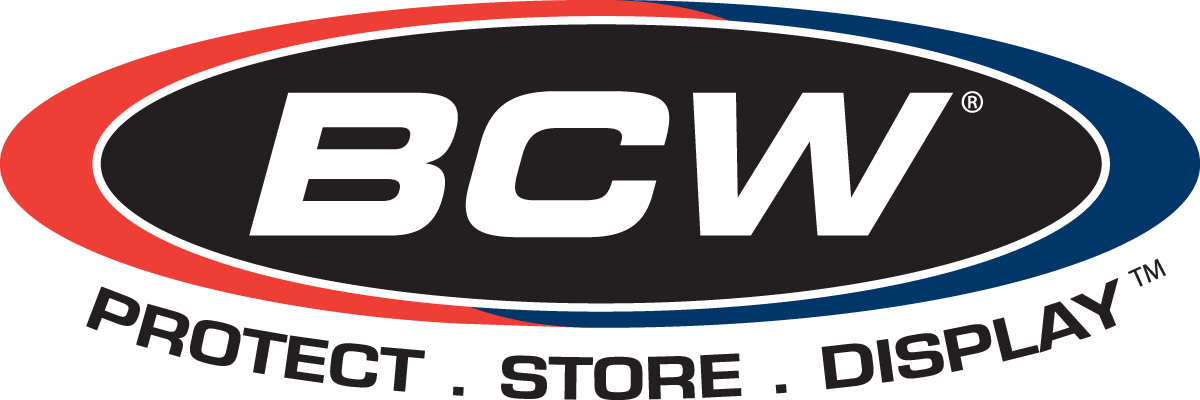Comic book collectors are serious about keeping their comics in mint condition. Protecting their comics by bagging and boarding is common practice. So when BCW Supplies claims our backing boards are “acid free”, collectors say “prove it”. BCW welcomes the challenge.
Originally posted by BCW Supplies on a Collectors Society forum on June 9th, 2011, the article below shows the results of an independent test performed by the Chicago Paper Testing Laboratory. The “SBS” boards mentioned below are solid bleached sulphate, a virgin fiber grade of paperboard.
Once again we would like to thank mschmidt for his thought provoking study which you can find here; http://boards.collectors-society.com/ubbthreads.php?ubb=showflat&Number=4534727&fpart=1
Based on Mike’s data and conclusions we decided to have the products that are represented in his experiment tested at an independent laboratory. Mike had concluded “that [SBS] boards will actively contribute, on a molecular level, to the decay of your comic book from the moment they’re placed inside the bag” based on the results of his testing using a pHydrion pH pencil. Mike stated that the calcium carbonate coating of the SBS board was absorbing only the acid from the board itself and that over time the SBS board would become completely acidic. However, we at BCW stated that we believe Mike’s conclusion is in error. We suggested that the fact that the coated side of the BCW board became more acidic with use over a two year period indicates that some of the residual acid from the comic book is being absorbed by the calcium carbonate coating on the board. Further, we suggested that the fact that the uncoated side of the BCW board did not change in pH over a period of two years of use meant that acid was not migrating from the SBS board to the comic book. As you will see, the data below supports our position.
We submitted samples to Chicago Paper Testing Laboratories, Inc. on 20 July 2011 and I was present in the laboratory on Tuesday 2 August 2011 for some of the testing. We had the lab perform TAPPI T-435 (pH) on a comic book (Marvel Comics Presents #61), E. Gerber Half-Back, BCW Comic Backing Board, Bill Cole Thin X-Tender, Miller Hobby Comic Backing Board, and an Ultra Pro Comic Backing Board. We also had them perform ASTM D-4988 (Alkaline Reserve) on an E. Gerber Half-Back, BCW Comic Backing Board, Bill Cole Thin X-Tender, Miller Hobby Comic Backing Board, and an Ultra Pro Comic Backing Board. In addition, we had them perform TAPPI T-401 (Fiber Analysis) on an E. Gerber Half-Back, BCW Comic Backing Board, and Bill Cole Thin X-Tender. And finally, we had the laboratory perform ASTM D-776 (Artificial Ageing) on a comic book (Marvel Comics Presents #61) and backing boards from both E. Gerber and BCW for 10 and 20 years.
Let’s look at the results of TAPPI T-435 (pH) from the samples submitted;
Comic Book pH 5.4
E. Gerber Half-Back pH 8.52
BCW Comic Backing Board pH 8.47
Bill Cole Thin X-Tender pH 8.57
Miller Hobby Comic Backing Board pH 9.36
Ultra Pro Comic Backing Board pH 7.94
As you can see, the comic book is acidic as expected. The boards all have relatively the same pH with Miller Hobby at the top of the scale and Ultra Pro at the bottom.
Now let’s look at the results of ASTM D-4988 (Alkaline Reserve);
E. Gerber Half-Back 7.69%
BCW Comic Backing Board 3.64%
Bill Cole Thin X-Tender 6.57%
Miller Hobby Comic Backing Board 4.45%
Ultra Pro Comic Backing Board 4.72%
From the data we can see that the E. Gerber Half-Backs and Bill Cole Thin X-Tenders actually have more than twice the Alkaline Reserve as advertised. The SBS boards all have about the same Alkaline Reserve with Ultra Pro at the top of the scale and BCW Supplies on the bottom.
Let’s take a look at the results of ASTM D-776 (Artificial Ageing);
Aged 10 years
Comic Book pH 5.45
E Gerber Half-Back pH 8.07
Comic Book pH 5.44
BCW Comic Backing Board pH 7.62
Aged 20 years
Comic Book pH 5.27
E Gerber Half-Back pH 8.07
Comic Book pH 5.26
BCW Comic Backing Board pH 7.34
From the data we can see that the E. Gerber Half-Back’s pH level does not change over a 10 year period which suggests that the E. Gerber Half-Back does not absorb any residual acid from the comic book. This is the conclusion that we drew from Mike’s data originally, and it is also the position of E. Gerber that their product does not absorb any residual acid from a comic book. It only acts as a stiffener. As the BCW Comic Backing Board absorbs some of the phenolic acid that migrates from the pages of a comic book the pH level of the board naturally decreases as the buffer reaches the saturation point (which is why we recommend that you change your boards every 3 to 5 years). Phenolic acid is released as lignin breaks down in the pages of a comic book and exhibits itself as the yellow residue that you see on a comic backing board after several years of use.
Please note that ASTM D-776 does not allow for the micro-environment that is created when sealing a comic book in a bag with a backing board. Therefore, we were not able to confirm our hypothesis that a comic book will deteriorate more quickly if the phenolic acid is not absorbed.
Now let’s look at the results of TAPPI T-401 (Fiber Analysis);
E. Gerber Half-Back
Bleached Kraft Softwood 12.1%
Bleached Kraft Hardwood 55.9%
Groundwood 32%
Unbleached Kraft Hardwood 0%
BCW Comic Backing Board
Bleached Kraft Softwood 9.6%
Bleached Kraft Hardwood 90.4%
Groundwood 0%
Unbleached Kraft Hardwood Trace
Bill Cole Thin X-Tender
Bleached Kraft Softwood 17.2%
Bleached Kraft Hardwood 61.1%
Groundwood 21.7%
Unbleached Kraft Hardwood 0%
SBS is stabilized paper board, meaning that it is made using a chemical process (also known as bleaching) where the lignin is removed from the pulp. This process does leave some residual acid in the SBS from bleaching and a buffer of calcium carbonate is added to stabilize the sheet. The paper mills have a target pH level of between 6.5 and 7.2 which means that the lower the buffer the less residual acid that remains in the paper. Bill Cole Thin X-Tenders and E. Gerber Half-Backs and Full-Backs are made of VAT board which has a coating on both sides that is bleached, but the core of the VAT board is made using mechanical pulp and contains lignin. The reason that this is important is that the lignin will eventually break down and the board could become acidic depending on how much calcium carbonate is in the board and how much phenolic acid is released.
There is between 32% and 21.7% Groundwood in the E. Gerber Half-Backs and Bill Cole Thin X-Tenders respectively. Because Groundwood contains lignin, the VAT board requires a greater Alkaline Reserve to remain stable. Note that the Alkaline Reserve of the E. Gerber Half-Back is greater than that of the Bill Cole Thin X-Tenders. This is because there is more Groundwood in the E. Gerber Half-Back and therefore requires more calcium carbonate to achieve roughly the same pH level as the Bill Cole Thin X-Tender.
Attached are copies of the documentation that we received from the laboratory for your reference.
Chicago Paper Testing Laboratory – Report 45892
Chicago Paper Testing Laboratory – Report 45892- DATA

